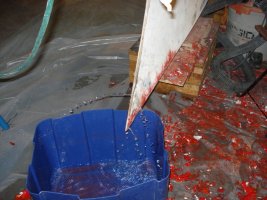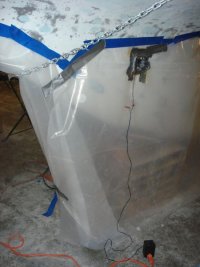Commotion
Member II
I bought this E 35-2 in the yard and while we were stripping the bottom paint off for barrier coat, we found water leaking out of the trailing edge of the keel. It tasted like salt water (yuck) and for the most part was pretty clear. It just kept coming, so I drilled a 1/4" hole... Ended up drilling a 2.5" hole through the side of the lowest point and one each on port and starboard of up toward the bow where it is still hollow. Drained all the water (guess about 15 to 20 gallons)
To dry it out, I tented the keel, attached a power supply fan to the port side hole to pull the air and put a radiant oil filled heater in the tent. I let that run for about two weeks. Nothing showed on the moisture meter, so I closed up the holes. Getting ready to apply three gallons of barrier coat.
The local boat yard said this is common and not to worry about it. But, I'm not a very good listener when it comes to not worrying. I realize it is very difficult to isolate the source, however, I am concerned that it could be coming in the tube for the drive shaft or perhaps from the bilge. I think I can seal the shaft tube well with barrier coat, but, doubt I can do much good in coating the bilge.
Are there keel bolts in this that I need to be concerned about?
Any thoughts or ideas are appreciated?
Rick
To dry it out, I tented the keel, attached a power supply fan to the port side hole to pull the air and put a radiant oil filled heater in the tent. I let that run for about two weeks. Nothing showed on the moisture meter, so I closed up the holes. Getting ready to apply three gallons of barrier coat.
The local boat yard said this is common and not to worry about it. But, I'm not a very good listener when it comes to not worrying. I realize it is very difficult to isolate the source, however, I am concerned that it could be coming in the tube for the drive shaft or perhaps from the bilge. I think I can seal the shaft tube well with barrier coat, but, doubt I can do much good in coating the bilge.
Are there keel bolts in this that I need to be concerned about?
Any thoughts or ideas are appreciated?
Rick


